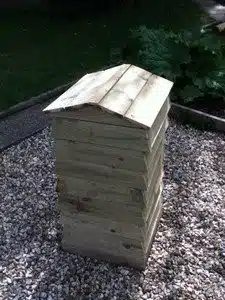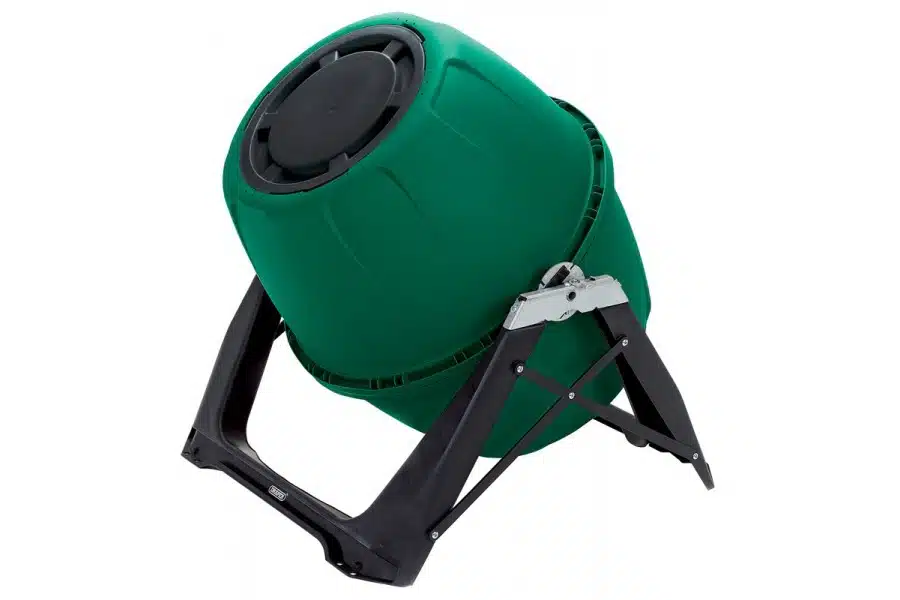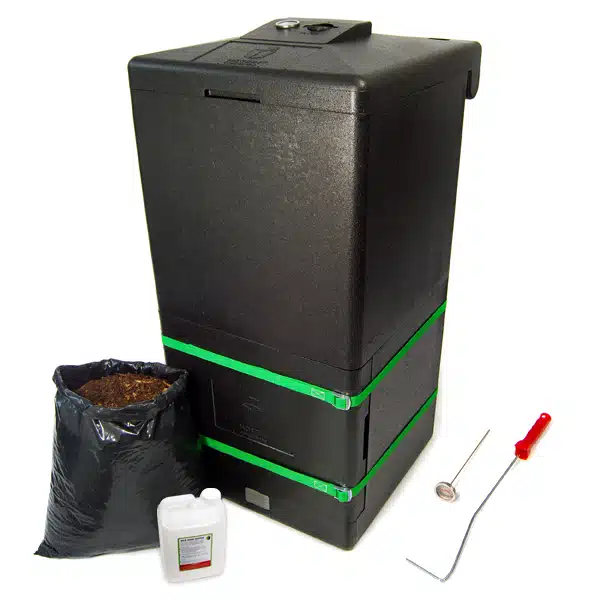Having a sense of self-sustainability is a big part of the draw of food growing. Without sounding too romantic, the whole endeavour is connected with nature and its basic ingredients: soil, seeds and the weather. So having a compost bin, creeping out onto the balcony or patio after dinner to add leftovers to the pile, really adds to the satisfaction.
The common image of a compost pile is that of a big panel-bounded heap of rotting garden waste. “Huge” being the operative word here. If you live in the countryside and have ever seen decomposing piles of manure in fields during summer, you’ll know what I mean. Yet you can just as easily have a small pile, a small bin, tucked away in a corner of your container or backyard garden.
In this little article, I want to have a look at some of the smaller options that are available to buy, picking out the best on the way. I do love composting and, if you’re yet to try it, I’m sure you will too…
A Note About Small Scale Composting
What’s small? For the purposes of this article, any bin that’s 200 litres or less will be classed as small. What this means is that those who want to get the biggest possible amount of compost out of their space will have an option of a large bin. That said, those that only have space for a small “bin” will be catered for too.
Many of the so-called “small compost bins” are actually caddies – they’re designed to hold waste until you can take it from the kitchen to the heap. They’re very small (usually only of a 4/5 litre capacity or so) and will make very poor composters if you make the mistake of accidentally using one. Just something to bear in mind.
The main issue with untended, open small compost heaps is that they tend not to produce enough heat to attract the aerobic microorganisms (mesophilic and thermophilic bacteria) that are needed to rapidly break down organic waste, which work in a temperature range of 70F/21C – 100F/38C. When a pile is large enough, the combined efforts of bacteria functioning at lower temperatures produce enough heat to attract those bacteria that thrive in higher ones.
So whilst very small heaps will decompose, their inability to generate heat means that the process will occur over a much longer period. So it’s important that we try and help the process along as much as possible: turning frequently, adding insulation if possible, and balancing the ingredients as well as possible. It’s always worth doing some home experimentation and you can buy a compost thermometer to track your pile’s temperature, which will give you a better idea of what’s going on.
As said, t is possible to speed up the process by balancing your mix well. Chopping green waste down, for instance, increases the surface area on which bacteria are able to process the organic material, insulating the bin with a black liner, putting it in a sunny spot, adding a little manure or soil, and maintaining the optimum amounts of nitrogen and carbon-containing materials will also help.
Whatever our circumstances, we want our “small” bin to be as big as possible. Fortunately, most small spaces can accommodate the type of bins included in this list, which tend to be no more than a meter or so high and fairly narrow. There are also a few other options if space really is at a premium:
Worm bin: Worm bins are (in my opinion) hands-down the best option for urban growers. You can have lots of nutrient-rich vermicompost (worm poo) in a relatively short time and you can remove the compost in one go or intermittently throughout the year. They are essentially small bins to which you add “red wriggler” worms, which will process your kitchen waste for you.
Bokashi: An old Asian composting method, Bokashi is one of the best options for small-space and urban container gardeners. The process, which requires a special bran, takes about two weeks. It doesn’t result in compost, but rather a “fermented” mix of food waste which then needs to be left to rot down fully. It’s main benefit is in speeding up the process
Top Picks for Small Compost Bins
So here’s our selection of seven small bins, one of which (I’m sure) you’ll fall in love with! Just click on the image to go to the corresponding website.
Darlac Garden Composter (Great for the Price) (UK Only)
A cheap and simple option. The Darlac composter is a thin bin (thin being the operative word here) so it will fit into a smaller area, making up for the lost width with its reasonable height. It’s got everything that you need: a waterproof plastic and fabric covering, holes for aeration and drainage, and (importantly) a zip lid and bottom panel from which to remove fresh compost. If you’re on a budget, the Darlac is your man (or bin, rather…).
Fiskars Eco Bin (US Only)
Fiskars is a great brand (their secateurs ranked high in our best picks) and I highly recommend their nifty little 70 litre compost bin. It’s made from a black mesh-like material, so aeration is top-notch. It also collapses down so is very easy to store when not in use. The one drawback is that the bottom is open, the basis (if you mind the pun) for which is to allow worms into the heap. If it won’t be resting on grass or soil, it shouldn’t be too much trouble to craft a base from mesh or plastic sheeting.
Compact Tumbler
The great thing about compact tumbler bins is that they’re very easy to aerate (you just rotate them a few times) and, because they’re raised above the ground, rodents are much less of a problem. This is of particular concern to those living in the city. The pictured Draper bin, for example, is stylishly compact. It’s a little bit overpriced for those in the US, so the Yimby Tumbler might be a better option.
Bosmere Small Wooden Compost Bin (UK & US)
[easyazon_image align=”center” height=”500″ identifier=”B00274XPJK” locale=”US” src=”https://www.urbanturnip.org/wp-content/uploads/2017/01/51nVTTvEnyL.jpg” tag=”urbanturnip-20″ width=”500″]
If you’re lucky enough to have some open ground, but are still gardening in limited space, then a small bin in the traditional design might be worthy of consideration. I’ve included it more for the sake of being thorough than anything else. I must admit I feel a little averse to forking out more than £100 for something that could be built cheaply. Nonetheless, if you’re short on time…
It’s unlikely to work well on a patio or balcony (especially if it’s a decking balcony) because of it’s open bottom design. Rodents may present a problem too. For a tiny London allotment, however, it will slot in perfectly.
Wooden Bee Hive Bin (UK Only)
 For those who want to go for a less plastic look, then a wooden “bee hive” bin may be the obvious choice. The problem with wooden composters that are produced on a large scale is that they are often of a low quality – cheap plywood badly tacked together. The one pictured on the left is handmade in Wiltshire with treated timber, so quality needn’t be a worry.
For those who want to go for a less plastic look, then a wooden “bee hive” bin may be the obvious choice. The problem with wooden composters that are produced on a large scale is that they are often of a low quality – cheap plywood badly tacked together. The one pictured on the left is handmade in Wiltshire with treated timber, so quality needn’t be a worry.
Its on the smaller side (though three different sizes are available), so give the mix as much attention as you can. Get the right balance of materials, keep it well aerated, and protect it with black tarp in the colder months (I know I’ve given that advice three times now).
Hotbin
I’m a huge fan of the Hotbin brand. It’s made from a thick foam-like material that means higher temperatures can be achieved much more easily, speeding up the composting process. You can have rich, friable compost in ninety days, which can easily be extracted from the bottom hatch. By adding green waste as it becomes available, you essentially have an uninterrupted system (so no need to add all waste in one go in order to achieve high temperatures). Indeed, it is preferable to add waste regularly, in addition to a bulking agent, to ensure high temperatures are maintained.
Though it is quite large (though by no means too big for a small garden or patio/balcony) it’s relatively easy to amend it so that it can work on a continuous basis for a smaller household. It’s worth spending some time on their website just to get an understanding of what’s involved. Once you do get the hang of it, however, I guarantee you’ll turn into a fan (like I did).
Worm Factory by Nature’s Footprint
[easyazon_image align=”center” height=”500″ identifier=”B002UO6LXE” locale=”US” src=”https://www.urbanturnip.org/wp-content/uploads/2017/01/51yQsfmWiVL.jpg” tag=”urbanturnip-20″ width=”441″]
One of the best worm bins on the market. If you’re short on space but want a steady supply of compost, then getting a wormery is the obvious way to go. The unique design of the worm factory makes it easier to extract the castings when they’re ready. The multi-tier system, which you can adapt to suit your own levels of waste, means that the worms migrate upwards, leaving the compost on the lower tiers available for use.
What Are Your Experiences?
So there you have it! My selection of the best small compost bins. Do get in touch if you have any brands or models that you’ve had particular success with and I’ll post the reviews! Happy composting!
More Resources
- Some more reviews of tumbler bins from The Daily Gardener.
Image Credit: Alan Levine



